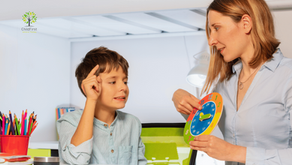Top 5 Myths About Kids with Autism
- ChildFirst Behavior Therapy

- Dec 12, 2019
- 3 min read

There are so many misconceptions about kids with autism. And as parents of a child with autism, my husband and I have heard many firsthand. Here are five of the biggest myths about kids with Autism Spectrum Disorder (ASD).
Kids with autism can’t express emotions (or don’t feel emotions in the first place).
In reality, kids who have autism experience the same emotions as any other kid: they’re happy, sad, angry and content at various times throughout the day. The difference is that kids with autism sometimes don’t express these emotions in expected ways, or when they do, their emotions seem extreme. Also, while kids with autism may not perceive the subtleties of your emotions—Autism Spectrum Disorder can make it difficult to read facial expressions—they pick up on emotions that are expressed more directly. Remember, every one of us had to learn how to label our emotions. Our kids with autism can definitely learn too.
Kids with autism aren’t interested in making friends.
On the contrary, kids with autism do want friends and social relationships. They usually just aren’t expressing their interest in those relationships like their peers readily do. But they often have deep interests in specific activities (like trains, Legos or puzzles), so you may find that when you engage a child on that topic, he or she lights up and becomes more talkative and social. When kids with autism seem distant or aloof, it’s usually just that their social skills aren’t as developed. Pay attention to indicators—like standing, pacing, or rocking next to a group of peers—that suggest they are interested in interacting but may not know the next steps. In general, it is important to recognize the desire all children have for friendship and the opportunities that naturally occur that can be used to forge a common bond.
Everyone with autism has the same few characteristics.
While there are some common behaviors among those diagnosed with autism, each is unique in their own way. There’s an old saying that holds true: “If you’ve met one person with autism, you’ve met one person with autism.” It’s important to remember that autism occurs on a spectrum, with some people showing only a few signs and others displaying more. Just because one person with autism has certain traits or behaviors, it doesn’t mean that another person will share those. Your child is unique, just as every child is unique. Only one thing is certain: he or she is capable of learning and growing in amazing ways. Not one person can predict how much or in what way but development is absolutely possible.
Autism is a life sentence to tantrums.
We have all seen kids tantrum in the grocery store, at the library, in the park, and a myriad of other places. We just assume it’s because they want something they can’t have or because they are generally badly behaved. We accept it as a normal part of childhood. Because toddlers with autism sometimes have more tantrums, some parents assume that their child will struggle with tantrums for their entire childhood. But it’s important to remember that tantrums are not a result of autism. They are often, not always, a result of language barriers and difficulty controlling emotions. These two areas of development happen to be significantly impacted by autism so tantrums are more likely to occur, however, tantrums are not a necessary occurence and can often be reduced with intervention. ABA therapy can help minimize tantrums and replace them with new behaviors, helping your child feel more at peace and teaching them how to express frustrations in a different way.
Kids with autism are a ticking time bomb.
Often, people assume that it’s only a matter of time before a child with autism acts out for some unforeseen or unexplained reason. Parents, friends and even other kids start to avoid children with autism because they think autism equals unpredictability. In fact, just like any other kids, kids with ASD do have reasons for their actions and reactions, and they’re not necessarily more unpredictable than other kids their age. The key to understanding any child’s behavior is to pay careful attention to what is happening right before and immediately after the behavior. Your child is leaving you a roadmap to why they are engaging in certain behaviors. So take heart and investigate their surroundings, knowing that your child never acts without purpose, even if you have yet to discover what that purpose is. If you are struggling to uncover why a particular behavior is happening, it may be time to bolster your efforts by consulting a Board Certified Behavior Analyst (BCBA).
Do you think your child might be ready for ABA therapy? Get in touch with us. We take a holistic approach to therapy, involving your whole family in the process. Contact ChildFirst to learn more.







Thank you for this powerful and much-needed post. Debunking these myths with such compassion and clarity is so important for fostering genuine understanding. This piece powerfully illustrates how these misconceptions can follow individuals throughout their lives, shaping their self-perception and how others interact with them. It's no wonder so many adults who grew up being misunderstood are now seeking to better understand their own neurotype. This journey of self-discovery is why accessible resources are so vital. For anyone in that position, I found that a comprehensive online autism screening can be an incredibly validating and informative first step.